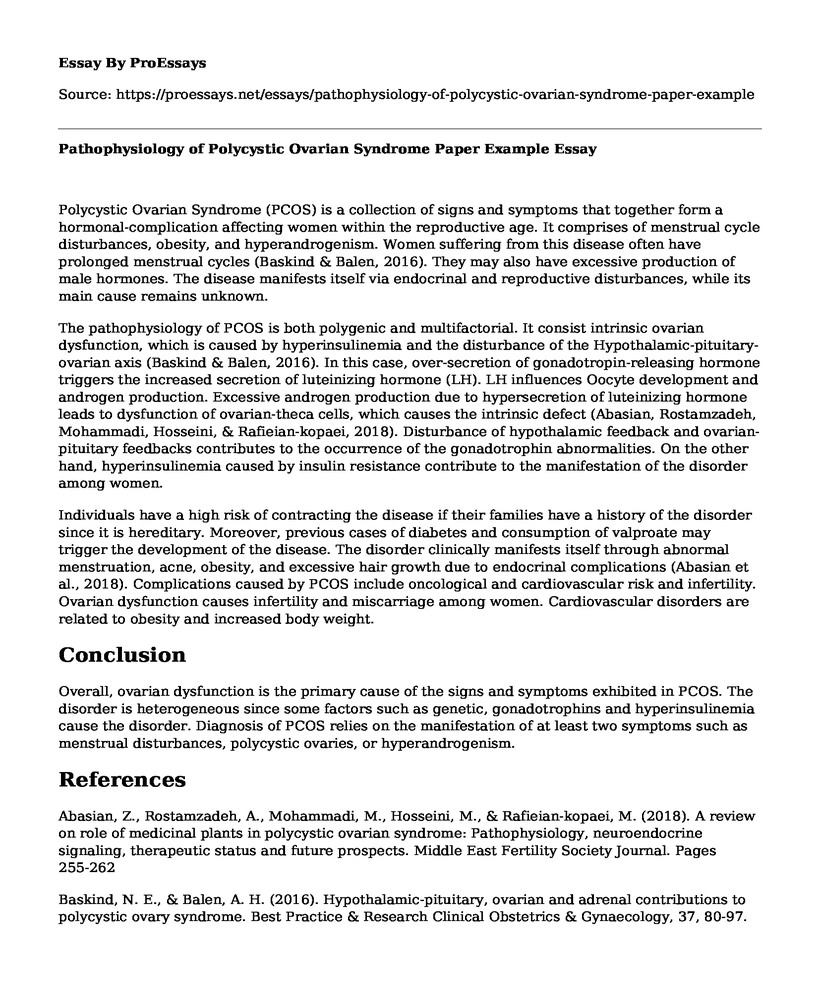Polycystic Ovarian Syndrome (PCOS) is a collection of signs and symptoms that together form a hormonal-complication affecting women within the reproductive age. It comprises of menstrual cycle disturbances, obesity, and hyperandrogenism. Women suffering from this disease often have prolonged menstrual cycles (Baskind & Balen, 2016). They may also have excessive production of male hormones. The disease manifests itself via endocrinal and reproductive disturbances, while its main cause remains unknown.
The pathophysiology of PCOS is both polygenic and multifactorial. It consist intrinsic ovarian dysfunction, which is caused by hyperinsulinemia and the disturbance of the Hypothalamic-pituitary-ovarian axis (Baskind & Balen, 2016). In this case, over-secretion of gonadotropin-releasing hormone triggers the increased secretion of luteinizing hormone (LH). LH influences Oocyte development and androgen production. Excessive androgen production due to hypersecretion of luteinizing hormone leads to dysfunction of ovarian-theca cells, which causes the intrinsic defect (Abasian, Rostamzadeh, Mohammadi, Hosseini, & Rafieian-kopaei, 2018). Disturbance of hypothalamic feedback and ovarian-pituitary feedbacks contributes to the occurrence of the gonadotrophin abnormalities. On the other hand, hyperinsulinemia caused by insulin resistance contribute to the manifestation of the disorder among women.
Individuals have a high risk of contracting the disease if their families have a history of the disorder since it is hereditary. Moreover, previous cases of diabetes and consumption of valproate may trigger the development of the disease. The disorder clinically manifests itself through abnormal menstruation, acne, obesity, and excessive hair growth due to endocrinal complications (Abasian et al., 2018). Complications caused by PCOS include oncological and cardiovascular risk and infertility. Ovarian dysfunction causes infertility and miscarriage among women. Cardiovascular disorders are related to obesity and increased body weight.
Conclusion
Overall, ovarian dysfunction is the primary cause of the signs and symptoms exhibited in PCOS. The disorder is heterogeneous since some factors such as genetic, gonadotrophins and hyperinsulinemia cause the disorder. Diagnosis of PCOS relies on the manifestation of at least two symptoms such as menstrual disturbances, polycystic ovaries, or hyperandrogenism.
References
Abasian, Z., Rostamzadeh, A., Mohammadi, M., Hosseini, M., & Rafieian-kopaei, M. (2018). A review on role of medicinal plants in polycystic ovarian syndrome: Pathophysiology, neuroendocrine signaling, therapeutic status and future prospects. Middle East Fertility Society Journal. Pages 255-262
Baskind, N. E., & Balen, A. H. (2016). Hypothalamic-pituitary, ovarian and adrenal contributions to polycystic ovary syndrome. Best Practice & Research Clinical Obstetrics & Gynaecology, 37, 80-97.
Cite this page
Pathophysiology of Polycystic Ovarian Syndrome Paper Example. (2022, Oct 06). Retrieved from https://proessays.net/essays/pathophysiology-of-polycystic-ovarian-syndrome-paper-example
If you are the original author of this essay and no longer wish to have it published on the ProEssays website, please click below to request its removal:
- Effective Learning of the Severely Disabled Students
- Do Cell Phones Cause Cancer?
- Essay Sample on Disease Epidemiology
- Essay on US Healthcare Reform: Senate-House Passes Act for Lower Prescription Drug Cost
- Research Paper on Mycoplasma Pneumonia: Atypical Bacteria Causing Mild Pneumonia
- EHR System: Administrative Processes & Benefits - Essay Sample
- Essay Sample on Ageing: Preparing for Physical Challenges & Modifying Lifestyle







